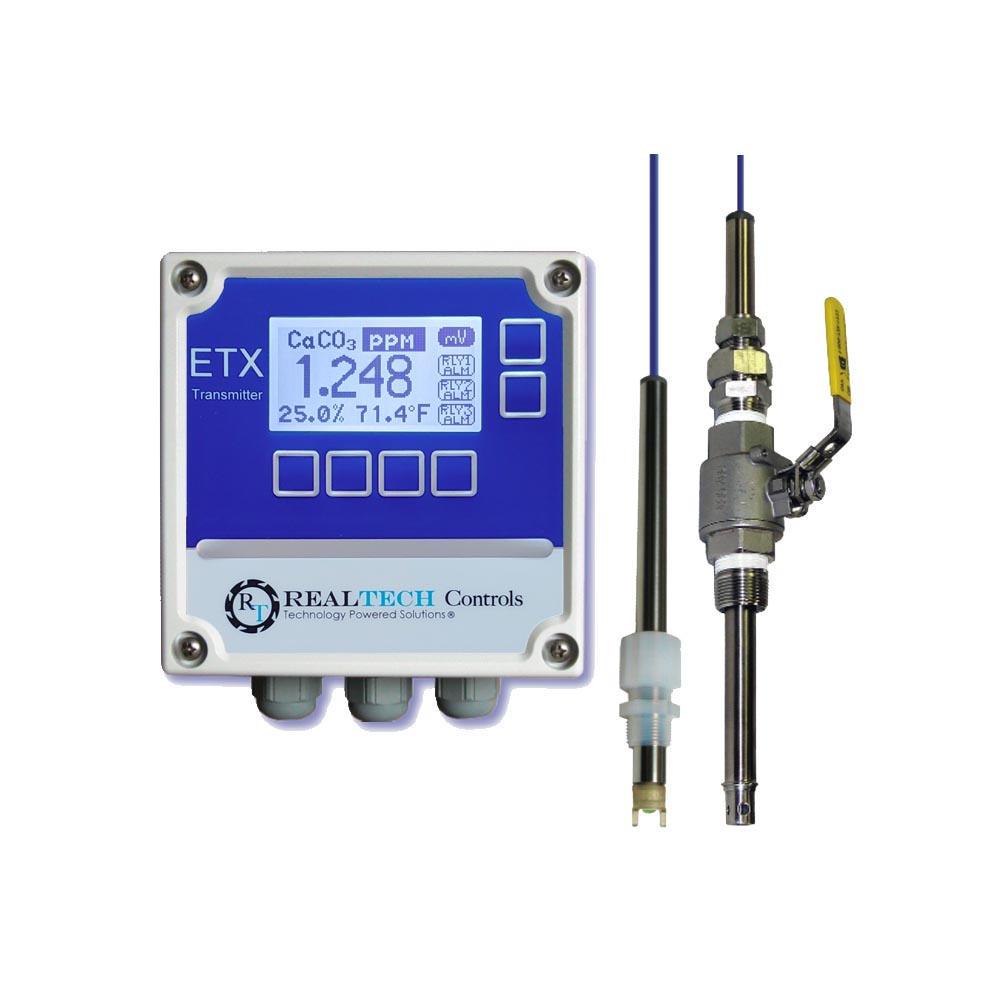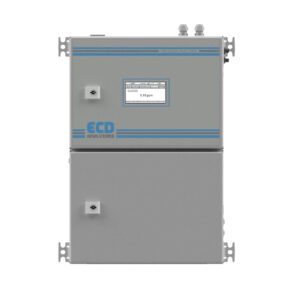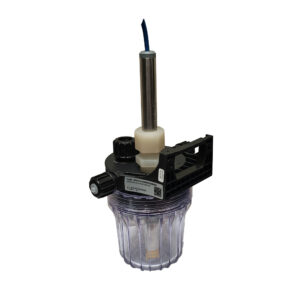Water Hardness Analyzer and Control System
The Water Hardness Analyzer and Control System offered by RealTech Controls has proven to be one of the most user-friendly, and versatile controllers on the market. Water Hardness is caused by the presence of calcium and magnesium carbonates. The ratio of calcium to magnesium is generally fixed, typically in the ratio 3:1 (Ca:Mg), therefore Total Hardness can be inferred, by knowing the amount of calcium present.
RealTech Controls offers two types of Water Hardness Analyzers:
-
The model ETX Transmitter is an online, real-time analyzer and uses the S80 Calcium Ion Sensor. This is an ion-selective electrode and measures the amount of Calcium in the water. The total hardness is calculated and displayed in ppm, ppt, or ppb on the front screen and can be selected for auto-ranging. The actual Calcium can be displayed if required.
-
The CA-6 colorimetric Water Hardness Analyzer uses reagents (chemical solutions) on a programmable timed cycle to determine the amount of calcium carbonate in the water. The CA6 is generally used for ranges below 1ppm, or if extreme accuracy is required for the readings.
Water Softener Brief:
The unit of Water Hardness measurement is usually ppm (milligrams/liter) of Calcium Carbonate (CaC03), and for the ETX + S80 system a normal working range is 1 ppm and above. This is the system normally used to measure the efficiency of a water softener, or city water hardness. The most common method of softening is by ion exchange using resin beds (traditionally referred to as Sodium Zeolite). The Sodium ion attached to the resin is exchanged for the Calcium and Magnesium ions. Another method is “precipitation” (lime), but this is gradually being replaced by ion exchange. The same equipment will work for both methods; but please check if the application is a hot lime process.
Magnesium is more soluble than Calcium and so it is more readily replaced by Sodium. This means the first indication that the softener train is failing is the increase of Calcium in the effluent. The measurement / control packages are used to detect this “breakthrough” of Calcium, indicating the need for the bed to be regenerated and a new bed to be switched in.
Sodium Zeolite does not reduce the alkalinity of the softened water; in some installations a Hydrogen Zeolite softener is run in parallel to the Sodium and the resulting effluents blended to give the desired pH (this provides an opportunity to provide pH analysis). The softener regeneration requires acids or bases (depending on the exchange method) requiring Conductivity measurement, as % acid or % base.
Products
- Measurement Range: 1 ppm to 40,000 ppm (3-11 pH), 5 x 10-7 molar to 1.0 molar
- Outputs: Single or dual channel 4-20mA outputs, with 3 x Relays, and MODBUS RTU
- Temperature Range: 0°C to 40°C (32°F to 104°F)
- Pressure Range: 0 to 50 psig (0 to 3.5 bar)
- Accuracy / Repeatability: Better than 5% of calibrated range
- Response Time: T90 in 10 seconds
- Electrode Life: 6 to 12 months
- Interfering ions: Lead (2:1), Mercury, Iron, Ammonium (1000-3000:1)
- Wetted Materials: Radel, epoxy, PVC, PTFE, 316 SS, Viton O-Ring
- Process connections: 3⁄4” MNPT compression fitting
- Options for retractable ball valve assembly: 1” MNPT Ball Valve
- Optional EMEC NPED3 sensor holder / flow cell
- Water Softeners
- Boiler Water
- Industrial wastewater
- Drinking water
- Effluent and influent monitoring
- Condensate and cooling water
- Surface water
- Process water
- Ideal for low range CaCO3 measurements
- Measurement Range: 0-500 ppb, or 0-1000 ppm
- Outputs: Single or dual channel 4-20mA outputs, with 4 x Relays, and MODBUS RTU
- Easy installation, with user-friendly touch screen interface
- Epoxy powder coated cabinet with two separate compartments
- Loss of sample & low reagent alarms
- Cost-effective, low maintenance
- Adjustable cycle time to minimize reagent usage
- Water Softeners
- Boiler Water
- Industrial wastewater
- Drinking water
- Effluent and influent monitoring
- Condensate and cooling water
- Surface water
- Process water
Accessories
The S80 Water Hardness sensor electrode must remain constantly submerged in water so it does not try out.
The EMEC NPED range of probe holders is designed so that when there is minimal or no flow, water is still present in the bowl. The design of the bowl also eliminates siphoning and ensures the sensor electrode stays submerged in water. The bowl can either be installed in-line or in a side-stream sample line, depending on the amount of flow required.
- Ideal for use with Water Hardness, pH, ORP, and Conductivity sensors
- Ensures sensors stay submerged in water
- Easy of Maintenance with removable bowl
- PP Body
- 72 PSI at 122°F (5 Bar at 50°C)
- Includes 6Ft Length of PE Tubing
- Simple Installation with wall mount bracket
- Bowls Available in Transparent or Black for outdoor installation
- Custom options for Number of Probes, Thread Type, and Flow Switch available, contact us
- Flow Cell accommodates 3/4″ MNPT Water Hardness Sensor
- Additional space for 2 x 12mm smooth-body pH and/or ORP sensors
- Custom Threads available for 3rd party probes



